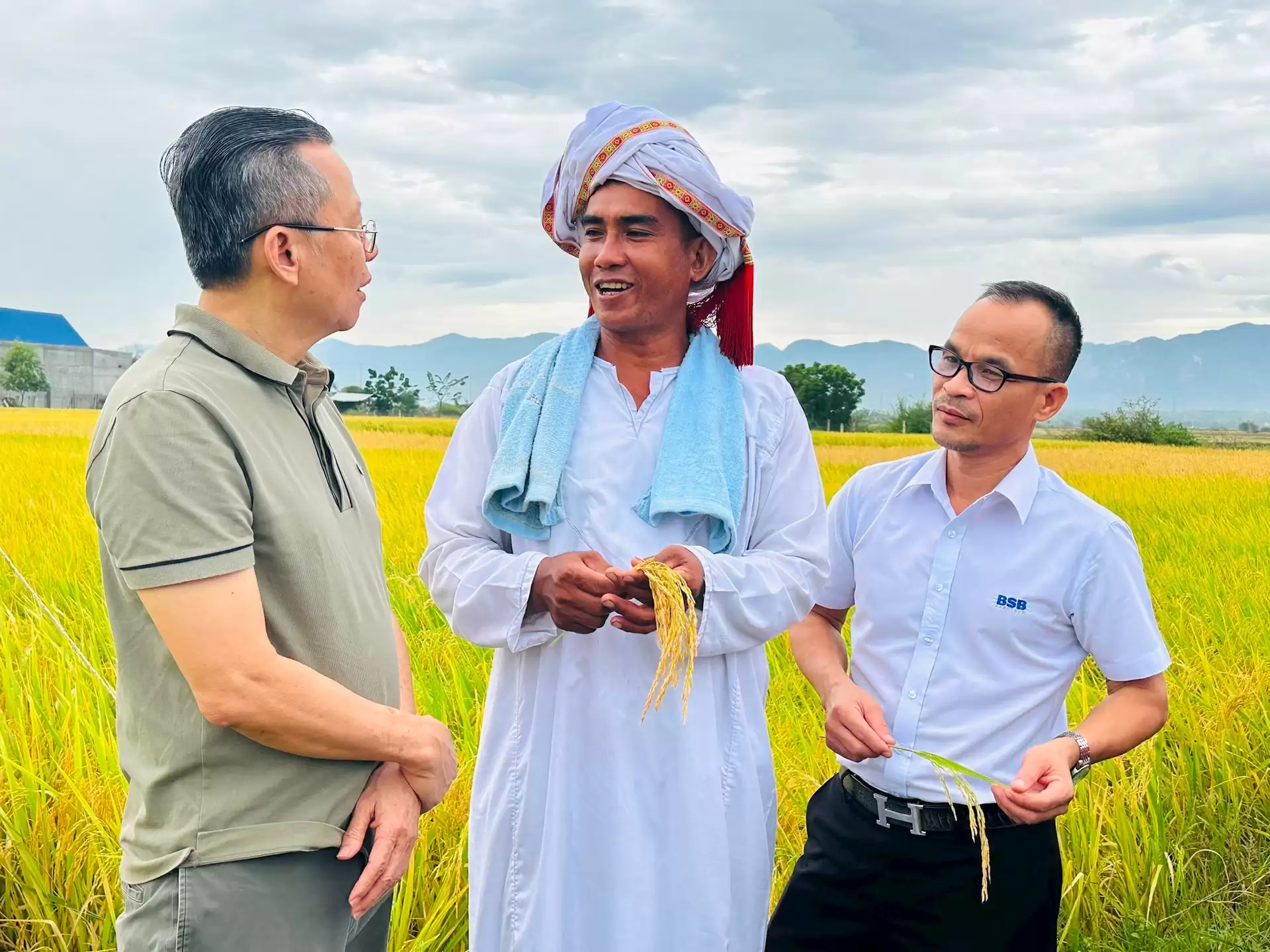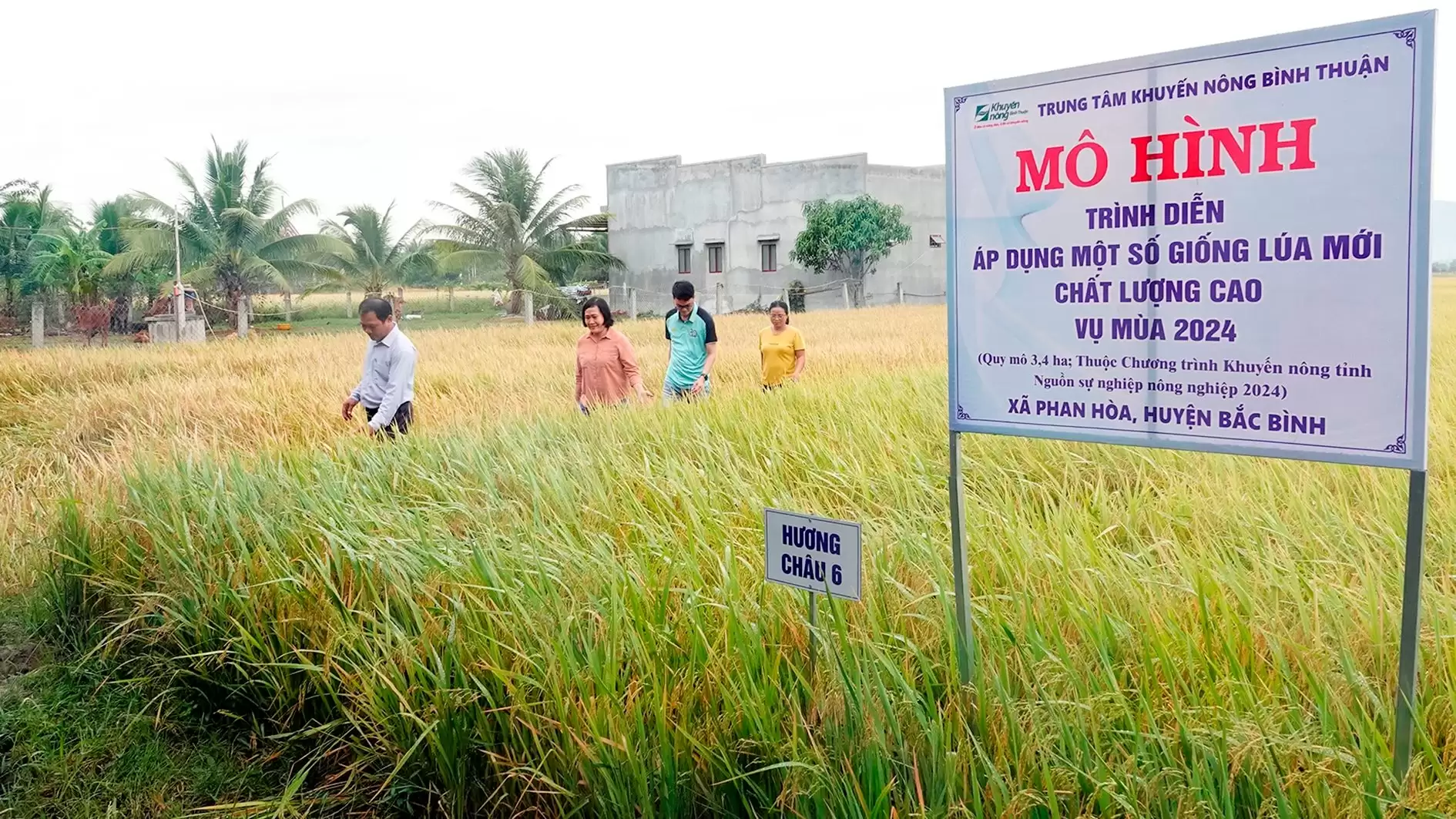This year, 11 Cham households in Phan Hoa embarked on a transformative journey by adopting a “smart” rice cultivation model. This innovative approach incorporates alternate wet and dry irrigation and reduces seeding density, paving the way for sustainable farming. Initially, the farmers faced uncertainty and hesitation, especially regarding sparse seeding practices compared to their traditional methods. However, tangible results—improved yields and additional income from carbon credit sales—soon replaced their doubts with enthusiasm.
The Fruits of Realized Profits
During the peak harvest season, the rice fields lining Bac Binh District’s highways turned into a vibrant golden sea of ripened crops. Farmers worked tirelessly to harvest and prepare for the next season. Amid this bustle, Cham farmers from Phan Hoa gathered at the Cut rice field in Binh Minh Hamlet to celebrate the outcomes of their hard work.
The gathering was part of a workshop titled “Application of High-Quality New Rice Varieties,” organized by the Provincial Agricultural Extension Center in collaboration with other stakeholders. The workshop marked the culmination of a successful trial program. Eleven Cham households cultivated 3.4 hectares of land under the model, supported by seeds, investment costs, and technical guidance.
Van Thi De Oanh, one of the participating farmers, expressed her excitement. “At first, I was worried about adopting this new method, especially with the reduced seeding density. But now, seeing the results, I’m overjoyed,” she shared. Oanh’s fields under the model delivered higher profits compared to her traditionally farmed plots, despite lower production costs.
The model emphasizes the “1 Must, 6 Reductions” technique: reducing seeds, pesticides, fertilizers, water, post-harvest losses, and greenhouse gas emissions. This comprehensive approach not only improves yields but also aligns with global sustainability goals, a point emphasized by Nguyen Thanh Huong, a senior engineer from BSB Nano Technology.

The Science Behind “Smart” Cultivation
Alternate wet and dry irrigation is central to the “smart” rice model. This structured watering method involves specific periods of drying the fields, which minimizes water usage while enhancing crop health. Rice plants require water for only 50 of their 95–100-day growth cycle, primarily during fertilization and weeding. The remaining days involve controlled drying, which has multiple benefits:
- Reduced Late Tillering: Ensures nutrients are focused on productive rice stalks.
- Methane Emission Reduction: Drying the fields breaks the anaerobic decomposition cycle, a major source of methane.
- Soil Health: Decomposed organic matter improves soil fertility and reduces pests.
These practices contribute to a more sustainable agricultural system. Farmers also benefit from additional income streams by selling carbon credits generated through reduced methane emissions.
Economic and Environmental Benefits
The program has proven highly effective. Participating farmers like Van Hong Xuan have observed increased yields and reduced costs. “My two sao of rice under this model are yielding about 8 tons per hectare, compared to 6.5–7 tons from the non-model fields,” Xuan explained, noting the additional savings from fewer inputs and decreased pest issues.
Beyond increased profits, the environmental benefits are significant. Methane reduction aligns with Vietnam’s commitments to global climate goals, showcasing the potential for agriculture to play a key role in combating climate change.
Shifting Mindsets and Practices
Bac Binh District, a key rice-producing region with over 39,300 hectares cultivated annually, has become a hub for innovative practices. Phan Hoa’s pilot program has transformed traditional farming practices, encouraging a shift towards sustainability. Farmers who were once hesitant are now advocates of the new methods, inspired by the economic and environmental advantages.
Tran Minh Tien, CEO of Net Zero Carbon, highlighted the broader implications: “This program not only improves farmers’ incomes but also positions Vietnam as a leader in sustainable agriculture. By selling carbon credits, farmers are directly contributing to global climate action while securing additional revenue streams.”

A Model for the Future
The success of the “smart” rice cultivation model in Phan Hoa is more than just a local triumph. It represents a scalable solution to the challenges of modern agriculture—balancing productivity, environmental conservation, and economic viability. As the program expands across the region, it has the potential to redefine rice farming in Vietnam, positioning the country as a global leader in sustainable agricultural practices.
About GreenUP
Pioneering the Green Transition with Expertise and Innovation. With over 10 million I-RECs issued since 2019, we are Vietnam’s leaders in renewable energy certification. Our comprehensive suite of services, positions us uniquely as a one-stop solution for all your green and ESG needs. Experience unparalleled market access, competitive pricing, and strategic partnerships that drive not only cost savings but also significant value to your sustainability goals.







